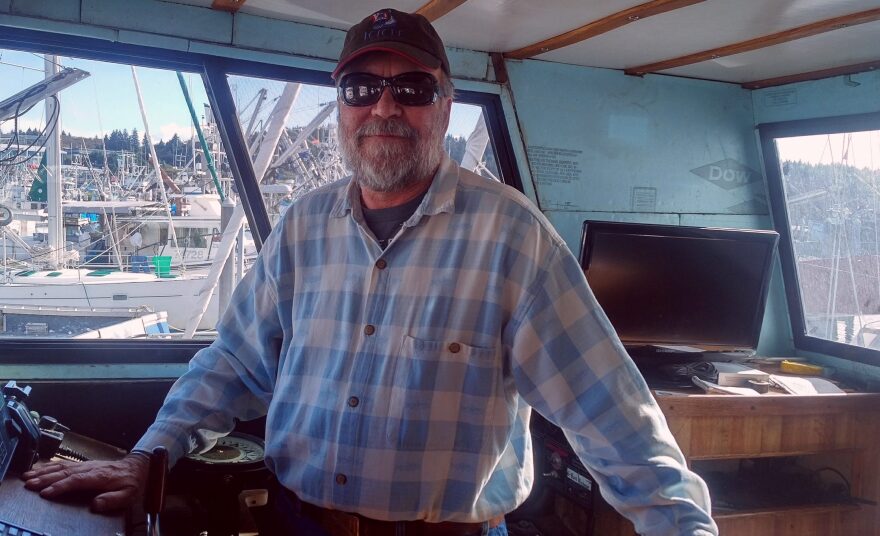Kodiak’s herring sac roe fishery opens April 1 at 9:00 a.m. with another year of massive harvest levels. But because of continued market problems, few local fishermen are expected to participate and a surplus of fish could be left in the water.
This year’s guideline harvest level is more than 8,000 tons for Kodiak’s sac roe herring fishery. James Jackson is an area management biologist with the Alaska Department of Fish and Game. He’s been with the department for more than two decades, and said this year’s herring biomass is at levels he’s never seen before.
“I’d say over the last four or five seasons we’ve seen near record biomasses, if not record biomasses in the Kodiak area. And that’s likely a result of limited fishing effort at times and some perfect environmental conditions, for one reason or another, that have made it so that the biomass of herring around the Kodiak area is about as big as it’s ever been,” Jackson said.
But without much of a market to sell all that herring sac roe, which is the female fish’s eggs, it’s not economical for herring fishers to harvest the record numbers of fish available around Kodiak.
Bruce Schactler has been fishing for herring for almost 50 years and is also the Global Aid Food Program Director with Alaska Seafood Marketing Institute. He said as far as he knows there won’t be a buyer for herring sac roe and he doesn’t plan on going out for sac roe this year. He describes himself as a recovering herring fisherman and said there really isn’t a Kodiak sac roe fishery that exists anymore. According to a state database however, Schactler owns multiple permits including one for this year’s Kodiak’s herring fishery as well as one in Cook Inlet.
Schactler put forward a proposal to Alaska’s Board of Fish during its meeting in January, in the hopes of changing how the fishery is managed. He suggested changing the timing of the fishery to allow for more herring fishing in the fall season, months after the spawning phase, when the fish are meatier. The two separate Kodiak fisheries, sac roe in the spring and food and bait in the fall would have been combined into one herring fishery under this proposal as well.
“If you want investment to come in, if you want new product development to come in, market expansion to come in, then the management needs to change to allow those fish to be harvested at various other times of their life cycle when they have the needed nutritional profiles for the various products that are going to be used,” Schactler explained.
The proposal would have also allowed for a rollover in unharvested GHL from the “A” season fishery which lasts from April 1 through May 15, to the “B” season later in the fall, which would last from Oct. 1 through Dec. 31.
Herring products range from canned fish to pickled herring or even salted roe sometimes eaten on kelp, like in dishes of kazunoko in Japan. But in Alaska the small, fatty and silvery fish is mainly used as bait for catching other commercial species such as crab or Pacific cod.
One of the factors preventing the food and bait fishery from being more lucrative in Kodiak is the harvest levels and the permits for fishers to participate are limited.
Jackson says more than 100 permits were issued in the past for Kodiak’s sac roe fishery while nine total, with five purse seine/gillnet permits and four trawl permits exist for the food and bait fishery. The Alaska Commercial Fisheries Entry Commission controls the number of permits in Kodiak’s herring fishery as well as other commercial fisheries across the state.
“The sac roe fishery used to be the more lucrative of the two [Kodiak] fisheries and so that’s why the lion’s share of the guideline harvest level is set based on the sac roe fishery, whereas the food and bait fishery is essentially ascribed 10% of what the sac roe guideline harvest level is,” Jackson said.
Ultimately, the Board of Fish decided not to take action on Schactler’s herring proposal. Yet he’s still pushing for management changes to open up more access to the resource.
“I stand by that as an example of what Alaska could do. I could go on and on into what we could do, and what actually, there are Alaska processors doing, and some of the potential,” Schactler said. “But none of the potential can be realized with management like it is now.”
Regardless of what management changes happen and when, fishers and the department alike hope the trend of increased herring biomass will continue in the coming years.
As of the morning of March 29, Fish and Game’s Jackson says no boats, tenders or processors had registered with the department for the upcoming sac roe fishery. He said he expects less than a quarter of this year’s catch will be harvested, leaving thousands of herring stranded in the water around Kodiak again this season. There is currently no rollover of unharvested GHL from the sac roe fishery in the spring to the food and bait fishery in the fall.
*Updated 04.02.2024: A previous version of this article stated that Bruce Schactler owns multiple Kodiak permits, when he only owns one Kodiak specific fishing permit. The article has been updated to reflect this. KMXT regrets the error.



